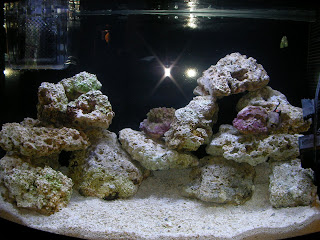 After having to downgrade my return pump, I knew I needed more flow in the tank. I looked at tons of different pumps and wavemakers for hours. I won't go into why each product failed to fit what I wanted. Instead, I'll just say that I am so glad I bought the VorTech. It's quiet (when adjusted to a reasonable power) and doesn't click when spinning up. Tons of flow. Since the motor is outside of the tank, almost no heat is transferred to the water. The controller has many programs and features like feeding mode, night mode, and coordinating wirelessly with multiple units. First I built a wave using short pulses that match the resonance of the tank. This wave is used in nutrient transport mode to sweep up detritus and then move it to the overflow. After that I tried out reef crest mode. I think that's what I'll be using for now. It'll be a while, but I'm very anxious to see what mode and configuration works the best for the coral.
After having to downgrade my return pump, I knew I needed more flow in the tank. I looked at tons of different pumps and wavemakers for hours. I won't go into why each product failed to fit what I wanted. Instead, I'll just say that I am so glad I bought the VorTech. It's quiet (when adjusted to a reasonable power) and doesn't click when spinning up. Tons of flow. Since the motor is outside of the tank, almost no heat is transferred to the water. The controller has many programs and features like feeding mode, night mode, and coordinating wirelessly with multiple units. First I built a wave using short pulses that match the resonance of the tank. This wave is used in nutrient transport mode to sweep up detritus and then move it to the overflow. After that I tried out reef crest mode. I think that's what I'll be using for now. It'll be a while, but I'm very anxious to see what mode and configuration works the best for the coral.Day 6















